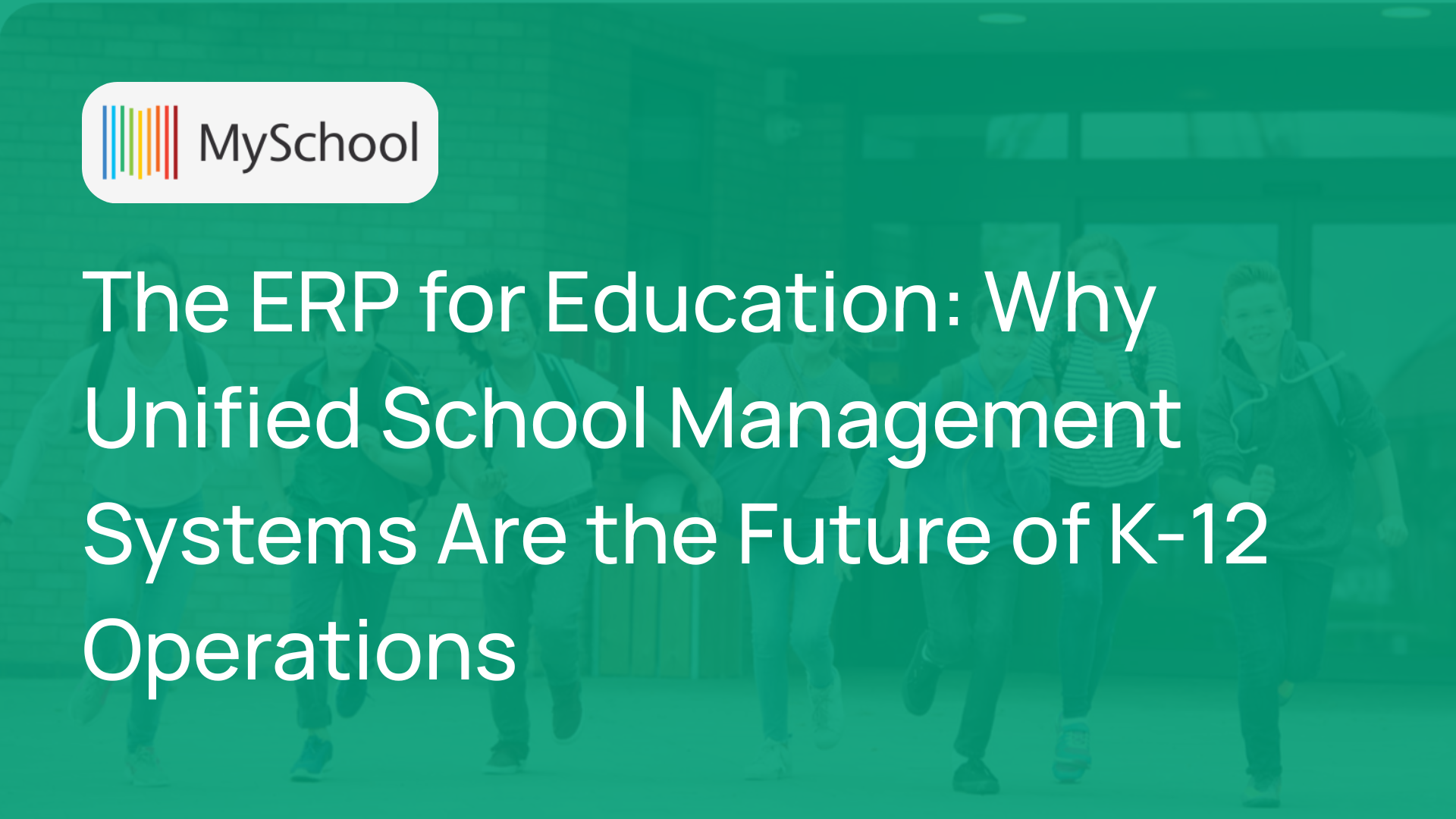The ERP for Education: Why Unified School Management Systems Are the Future of K-12 Operations
“The greatest danger in times of turbulence is not the turbulence, it’s acting with yesterday’s logic” – Peter Drucker, Austrian-American consultant and educator
The King's School in Canterbury, England, is the oldest in the world that still exists and operates to this day. Since its inception in 597 AD, a great deal has changed in the way it’s managed. One could argue that following traditional governance values is what ensured the King’s School’s success. However, I believe it’s the adaptability that makes educational institutions powerful enough to withstand the trials of time.
Being adaptable has as much to do with education standards as it does with administration and operations. Arguably, looking for excellence here requires glancing beyond education and towards business principles.
One may consider the example of how ERP systems transformed the business landscape of the 1990s.

Unified school management platforms are poised to redefine education in the 2030s in the same way. This article will describe how exactly this can happen and what your school management practices need to excel, instead of trying to keep up with the competition.
The Challenges of School Management in 2025-2030
To better understand what lessons your school can learn from the business world, let’s first clearly define the challenges you are already facing or most likely will face in the near future.
While the teaching aspect of K-12 education is not changing that fast (and the trends are rather predictable), the tech industry is rapidly evolving, especially with the current AI-everything ideology. Which is good news, not bad.
You need to understand where, when, and how to apply that technology. For school management in particular, there are specific pain points that can be solved.
Data Fragmentation and System Overload
The average K-12 institution today operates 10-15 separate software systems for attendance, learning management, finance, HR, and communication. Those systems are rarely synchronized.
While each platform serves a specific function, it also creates data silos. Teachers re-enter the same student information in multiple places. Administrators reconcile spreadsheets across departments. Leaders spend hours trying to build reports that should take seconds.
The cost of this fragmentation isn’t just time. When data lives in different systems, decision-making becomes guesswork.
Rising Administrative Burden
School administrators spend up to 40% of their time on compliance and reporting tasks. In many districts, these processes rely on manual data entry or outdated integrations.
The result is burnout and less time for what matters most: leading and supporting educators.
Expectations for Transparency and Personalization
Parents and students expect seamless digital communication, similar to the apps they use every day. 85% of parents now expect real-time updates on grades and attendance.
When schools can’t deliver this level of transparency, frustration grows; not because teachers aren’t doing their jobs, but because systems aren’t aligned. This can get quite frustrating for operations and IT teams, as they don’t know how to solve these problems.
Financial Pressures and Resource Constraints
Budgets are tightening worldwide. Inflation and staffing shortages mean schools must find new efficiencies. Yet, 60% of K-12 institutions report financial shortfalls in 2025. Fragmented systems drain resources through redundant software licenses, duplicated work, and missed opportunities for optimization.
Integrated systems, by contrast, reduce administrative costs by up to 25%.
Preparing for a Digital-First Generation
By 2030, Gen Alpha will make up most of the student population, a generation raised on instant feedback, AI assistants, and personalized digital experiences.

Schools that don’t adapt will find themselves out of sync not only with technology but with culture. Integration isn’t just operational, it’s generational.
Lessons from the ERP Revolution
To understand the path forward for schools, it helps to revisit how businesses solved a similar problem.
In the 1980s and 1990s, global enterprises like Nestlé, Nike, and Airbus faced chaos: siloed departments, incompatible software, and inconsistent reporting. Each division, be it finance, HR, or logistics, operated on separate systems.
The result: duplication, inefficiency, and data chaos. Sounds familiar?
Then came ERP systems (Enterprise Resource Planning), pioneered by companies like SAP. These platforms unified every business process into a single system, creating a “single source of truth” for the entire organization.
- SAP now supports 77% of the world’s transaction revenue (SAP Annual Report, 2024).
- Businesses using ERPs report up to 30% faster decision-making and significant cost reductions (PwC ERP Benchmark, 2023).
The lesson is simple: complex organizations cannot afford silos.
The ERP Mindset for Schools
Schools, though mission-driven rather than profit-driven, face similar structural challenges to corporations:
- Multiple departments with overlapping responsibilities.
- Redundant data across isolated systems.
- The need for accurate, timely information to make strategic decisions.
What’s missing in most K-12 institutions is the ERP mindset. It is the idea that every function, from academics to finance, operates as part of one interconnected whole.
In this model, data doesn’t just serve one department, but rather powers the entire organization. For instance:
- Admissions data flows directly into student records and billing.
- Academic performance feeds into analytics that inform staffing or intervention strategies.
- Parent communication is logged alongside academic progress, giving educators a complete picture of student engagement.
This kind of system isn’t futuristic. It’s already here, and it’s reshaping how schools operate.

From Silos to Systems: How Unified Platforms Drive Change
Schools adopting unified management ecosystems report improvements that go far beyond efficiency. Integration transforms culture and outcomes.
1. Operational Efficiency
Automated workflows replace manual reconciliation. Staff gain back hours each week. Leaders see all data in one place, enabling quick, informed decisions.
2. Data Accuracy and Insights
When systems share a database, data integrity improves dramatically. Analytics can generate insights on attendance, financial health, and student performance, unlocking proactive decision-making rather than reactive problem-solving.
3. Better Communication and Community Engagement
A single platform means consistent communication across teachers, parents, and students. Notifications, reports, and updates flow automatically, building trust and transparency.
4. Strategic Leadership
With real-time dashboards, school leaders can monitor operations like CFOs monitor a company’s balance sheet. This clarity empowers strategy, not just administration.
5. Future-Proofing Through Integration
As technology evolves, from AI tutoring to predictive analytics, unified platforms are best positioned to integrate these innovations seamlessly. Fragmented systems, by contrast, struggle to adapt.
Case Study: How MySchool helped The Study Academy handle daily admin work 200% faster
Few examples capture the power of a unified school management ecosystem better than The Study Academy, an independent K–12 school in Toronto that specializes in supporting twice-exceptional (2E) students.
Before MySchool, the school struggled with fragmented tools, disconnected spreadsheets, and outdated systems that couldn’t meet the complex needs of individualized education plans (IEPs). After two failed SIS transitions and mounting administrative chaos, they turned to MySchool… and achieved measurable transformation almost instantly.
Within weeks, The Study Academy cut administrative time by more than 200%, simplified scheduling, and made provincial reporting effortless. Principal Bradley Gunter called the transition “smoother than any previous SIS change,” praising the flexibility, ease of onboarding, and Canadian-specific compliance features that made MySchool feel like it was built just for them.

What followed was a complete operational shift. Communication that once took 20 minutes now takes 20 seconds, attendance follow-up dropped from two hours to just a few minutes, and a full-year timetable can now be built in under an hour.
The result is not only greater efficiency but stronger connections between educators, students, and families. That is the proof that when technology unifies operations, it can also amplify a school’s mission.
The Future of K-12 Operations: Intelligent, Integrated, Insightful
Looking toward the 2030s, the future of school management is not just digital but intelligent integration. Emerging technologies will make unified systems smarter:
- AI analytics will predict attendance patterns or resource needs.
- Machine learning will flag at-risk students early.
- Automation will handle scheduling, reporting, and even basic parent inquiries.
- APIs and interoperability standards will allow seamless communication between educational tools and external systems.
Schools that embrace this now will lead the next generation of education, not just in learning outcomes, but in operational excellence.
Introducing MySchool: The ERP for Education
At MySchool, we believe that running a school should be as unified, intelligent, and data-driven as running a global enterprise, without ever losing the heart of education.
Our School Management Ecosystem is an all-in-one platform that connects every department, stakeholder, and workflow under a single digital roof. Designed specifically for independent K-12 schools, it replaces multiple disjointed systems with one intuitive, cloud-based hub.
- Academics & Learning: Streamline curriculum planning, grading, and attendance while supporting diverse learning needs, IEPs, and real-time insights for teachers and parents.
- Finance & Tuition Management: Automate invoicing, payments, and financial reporting with flexible tuition plans and integrations for QuickBooks, PAD, ACH, or SEPA.
- Admissions & Advancement: Simplify enrollment and re-enrollment with smart forms, document management, and built-in donor and alumni engagement tools.
- Communication & Community: Strengthen parent relationships with centralized portals, messaging, and live updates on schedules, invoices, and student progress.
- Provincial Reporting & Compliance: Generate and submit Ministry reports with ease. MySchool automates provincial data requirements, ensures full compliance with Canadian education standards, and securely stores data on locally hosted Canadian servers that meet EU-level privacy regulations.
With a single source of truth for all school data, MySchool eliminates errors, improves decision-making, and ensures everyone – from the principal to the parent – has access to reliable, real-time information.
More than software, MySchool is a partner in transformation. Schools benefit from a 99.6% support ticket resolution rate, personalized onboarding, and a dedicated Customer Success Manager who ensures every implementation succeeds.
It’s not about replacing human insight with automation; it’s about giving leaders clarity to lead confidently and freeing educators to focus on what matters most: students and learning.
Conclusion: From Chaos to Clarity
Just as ERP systems redefined how companies like Nestlé and Nike operate, unified school management systems will redefine how schools lead in the 2030s.
Education is entering its digital renaissance. One that rewards adaptability, integration, and vision. The schools that thrive will be those that view operations not as an afterthought, but as a foundation for excellence.
MySchool’s unified ecosystem is more than just software; it’s a philosophy of modern school leadership: connected, data-driven, and mission-aligned.
It’s time to stop acting with yesterday’s logic and start building the schools of tomorrow.
Related Posts

The ERP for Education: Why Unified School Management Systems Are the Future of K-12 Operations
“The greatest danger in times of turbulence is not the turbulence, it’s acting with yesterday’s logic” – Peter Drucker, Austrian-American consultant and educator

6 steps to effectively earning staff buy-in for new school initiatives
Implementing your new year's initiatives at your school can be tricky because it means changes are going to happen. And change can be a four letter word.
.png)

